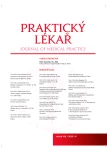Health effects of coal combustion
Authors:
L. Křivohlavá
Authors‘ workplace:
Vedoucí: prof. MUDr. Leoš Navrátil, CSc., MBA, dr. h. c.
; Děkan: prof. MUDr. Ivan Dylevský, DrSc.
; Fakulta biomedicínského inženýrství, Kladno
; Katedra zdravotnických oborů a ochrany obyvatelstva
; České vysoké učení technické v Praze
Published in:
Prakt. Lék. 2020; 100(6): 267-269
Category:
Reviews
Overview
Burning coal in power plants emits more particulate matter, sulfur dioxide, nitrogen oxides, and heavy metals per unit of energy than any other fuel source. Coal is also the largest contributor to the human-made increase of CO2 in the atmosphere and according to the International Energy Administration, coal combustion is responsible for more than 30% of the average global temperature increase (since preindustrial times). Climate change is now widely recognised as the biggest global threat of the 21st century. Between 2030 and 2050, climate change is expected to cause approximately 250 000 additional deaths per year, from heat stress, malnutrition, diarrhoea and malaria (according to the WHO).
Keywords:
Coal – Air pollution – Climate change
Sources
1. Castleden WM, Shearman D, Crisp G, Finch P. The mining and burning of coal: effects on health and the environment. Med J Aust 2011; 195(6): 333–335.
2. Santo TLH, Emphysema and chronic obstructive pulmonary disease in coal miners. Curr Opin Pulm Med 2011; 17(2): 123–125 [cit. 2020-10-18].
3. Kravchenko J, Lyerly KH. The Impact of Coal-Powered Electrical Plants and Coal Ash Impoundments on the Health of Residential Communities. N C Med J 2018; 79(5): 289–300 [cit. 2020-10-19].
4. EASAC. The imperative of climate action to protect human health in Europe [online]. Dostupné z: https://easac.eu/fileadmin/PDF_s/reports_statements/Climate_Change_and_Health/EASAC_Report_No_38_Climate_Change_and_Health.pdf [cit. 2020-07-17].
5. Sajjad A, et al. Climate Change and Its Impact on the Yield of Major Food Crops: Evidence from Pakistan. Food 2017; 6(6): 39.
6. Česalová K. Environmentální historie znečištění ovzduší na příkladu vybraných závažných situací ve světě (bakalářská práce, 2013), [online]. Dostupné z: https://geography.upol.cz/soubory/studium/bp//2013-geo/2013_Cesalova.pdf [cit. 2020-10-17].
7. Šrám RJ. Vliv znečištění ovzduší na zdraví obyvatel – Program Teplice [online]. Dostupné z: https://www.sisyfos.cz/clanek/207-vliv-znecisteni-ovzdusi-na-zdravi-obyvatel-program-teplice [cit. 2020-09-22].
8. Perera F. Pollution from fossil-fuel combustion is the leading environmental threat to global pediatric health and equity: solutions exist. Int J Environ Res Public Health 2018; 15(1): 16 [online]. Dostupné z: https://www.ncbi.nlm.nih.gov/pmc/articles/PMC5800116/ [cit. 2020-07-17].
9. Hendryx M, Zullig KJ, Luo J. Impacts of coal use on health. Annu Rev Public Health 2020; 41: 397–415 [online]. Dostupné z: https://www.annualreviews.org/doi/full/10.1146/annurev-publhealth-040119-094104 [cit. 2020-07-17].
10. HEAL. Was Kohlestrom wirklich kostet (Gesundheitsfolgen und externe Kosten durch Schadstoffemissionen) [online]. Dostupné z: https://www.env-health.org/IMG/pdf/heal_coal_report_de.pdf [cit. 2020-07-17].
11. Haynes A, Scheelbeek P, Abbasi K. The health case for urgent action on climate change. BMJ 2020; 368: m1103 [online]. Dostupné z: https://www.ncbi.nlm.nih.gov/pmc/articles/PMC7190277/ [cit. 2020-07-17].
12. Kharecha PA, Kutscher CF, Hansen JE, Mazria E. Options for near-term phaseout of CO(2) emissions from coal use in the United States. Environ Sci Technol 2010; 44(11): 4050–4062.
13. Hong BD, Slatick ER. Carbon dioxide emission factors for coal [online]. Dostupné z: https://www.eia.gov/coal/production/quarterly/co2_article/co2.html [cit. 2020-07-17].
14. NASA. Graphic: The relentless rise of carbon dioxide [online]. Dostupné z: https://climate.nasa.gov/climate_resources/24/graphic-the-relentless-rise-of-carbon-dioxide/ [cit. 2020-07-17].
15. Jacobson TA, Kler JS, Hernke MT, et al. Direct human health risks of increased atmospheric carbon dioxide. Nat Sustain 2019; 2: 691–701 [cit. 2020-07-18].
16. Azuma K, Kagi N, Yanagi U, Osawa H. Effects of low-level inhalation exposure to carbon dioxide in indoor environments: a short review on human health and psychomotor performance. Environ Int 2018; 121(Pt 1): 51–56 [cit. 2020-07-18].
Labels
General practitioner for children and adolescents General practitioner for adultsArticle was published in
General Practitioner

2020 Issue 6
Most read in this issue
- Use of the toe brachial index to detect lower extremity arterial disease in diabetics
- Listeriosis in the Czech Republic and the European Union – recent situation and the risk communication
- Health effects of coal combustion
- Exercise in the treatment of diabetes mellitus
